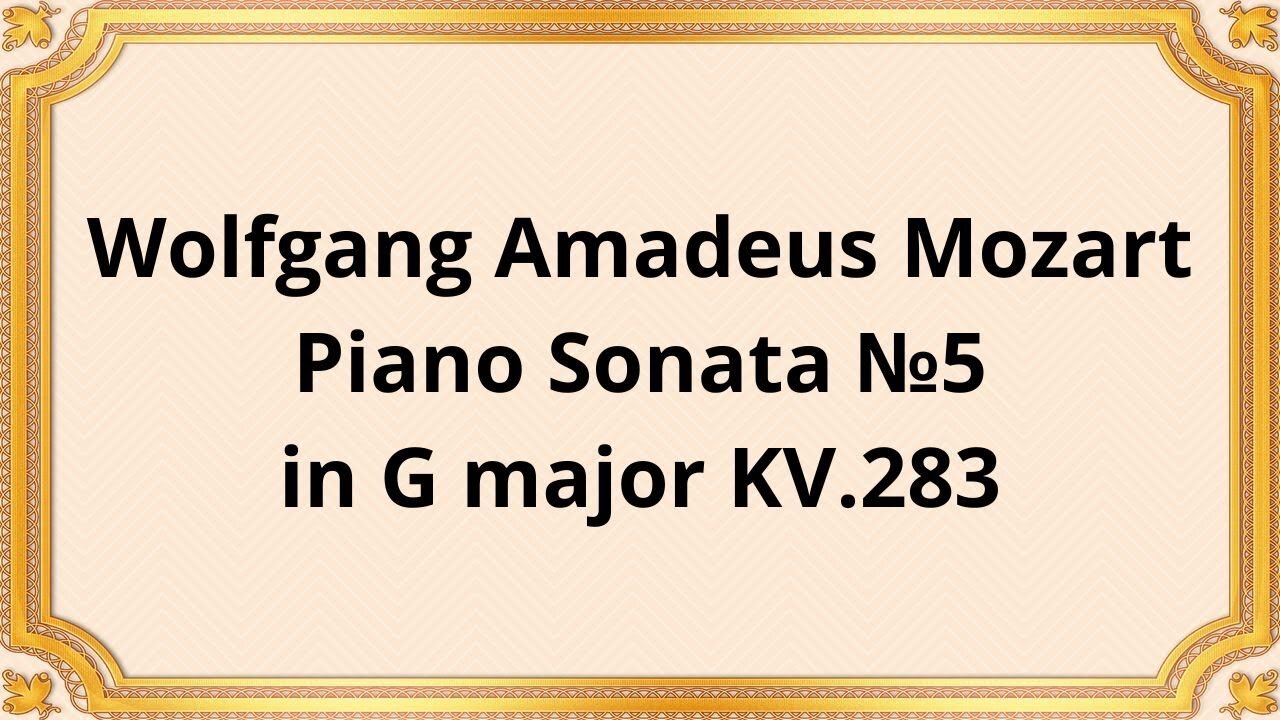Premium Only Content

Wolfgang Amadeus Mozart Piano Sonata №5 in G major KV.283
#classicalmusic #Mozart #chambermusic #sonata #piano #WolfgangAmadeusMozart #PianoSonataNo5 #GMajor #KV283 #MusicalComposition
Publication date 1951
Jacqueline Blancard, piano
Wolfgang Amadeus Mozart, a legendary figure in the world of music, has left an indelible mark with his extraordinary compositions. Among his vast oeuvre, the Piano Sonata No. 5 in G major KV.283 stands as a shining example of his prodigious talent and musical genius.
Composed in 1774, during the Classical period, Mozart's Piano Sonata No. 5 reflects the style and aesthetics of the time. This period emphasized clarity, balance, and elegance in musical compositions, and Mozart's sonata perfectly encapsulates these characteristics. It showcases the transition from the Baroque era to the emerging Classical era, revealing Mozart's innovative approach to composition.
The sonata follows the traditional three-movement structure, commonly found in classical compositions of the time. The first movement, marked Allegro, presents the main theme with its lively and spirited character. The second movement, marked Andante, provides a contrasting mood, with its lyrical and introspective melodies. Finally, the third movement, marked Presto, brings a sense of virtuosity and excitement, showcasing Mozart's technical brilliance.
Mozart's gift for melody is evident throughout the sonata. The first movement presents a memorable and catchy theme, which is skillfully developed and varied throughout the piece. The second movement offers a beautiful and poignant melody, evoking a sense of emotional depth. Harmonically, Mozart's use of chord progressions and modulations adds richness and complexity to the composition, captivating the listener's ear.
Piano Sonata No. 5 in G major is crafted with technical intricacy, showcasing Mozart's virtuosity as a pianist and composer. The composition demands precision, agility, and control from the performer, making it a favorite among skilled pianists. Mozart's meticulous attention to detail and his ability to blend technical complexity with expressive artistry are evident in the fast-paced passages, rapid scales, and intricate ornamentation found within the sonata.
Mozart's Piano Sonata No. 5 in G major KV.283 has had a lasting impact on the world of classical music. Its technical brilliance and melodic beauty have influenced countless composers and performers. The sonata continues to be studied, performed, and cherished by musicians and audiences worldwide. Its enduring popularity is a testament to Mozart's profound contribution to the musical landscape.
Conclusion:
Wolfgang Amadeus Mozart's Piano Sonata No. 5 in G major KV.283 is an exceptional musical work that showcases the composer's extraordinary talent and musical innovation. Through its structure, melodic richness, technical complexity, and enduring legacy, this sonata stands as a testament to Mozart's genius. By exploring and appreciating this remarkable composition, we gain a deeper understanding of Mozart's contribution to classical music and the timeless beauty of his musical creations.
You have the opportunity to support the channel:
https://destream.net/live/RadSiarAl/donate
https://www.buymeacoffee.com/6355radsiaral
-
 18:26
18:26
Classical music_Music Inspiration
1 month agoLudwig van Beethoven Piano Sonata No. 8 in C minor, Op. 13 "Pathétique"
601 -
 16:23
16:23
GritsGG
12 hours agoWorld Record Call of Duty Win Streak Attempting!
6161 -
 2:02:54
2:02:54
Side Scrollers Podcast
17 hours agoJOEY SWOLL/HULK HOGAN CONTROVERSY + ONLINE SAFETY ACT + MORE | SIDE SCROLLERS
19.4K2 -
 1:05:44
1:05:44
Omar Elattar
9 months agoThe Digital Real Estate Expert: You're Being Lied To About Making Money Online!
1.07K -
 10:53
10:53
Nikko Ortiz
2 days agoWORST Clips On The Internet
81.4K27 -
 3:42:38
3:42:38
FreshandFit
12 hours agoREAL R*pe Victim Exposes Shannon Sharpe Accuser As Liar!
70.1K69 -
 2:18:29
2:18:29
Badlands Media
14 hours agoDevolution Power Hour Ep. 376: Optics, Explosions & the War for the Narrative
138K43 -
 37:46
37:46
Stephen Gardner
12 hours ago🔥Trump NEVER expected THIS WIN as Schumer has EPIC MELTDOWN!
39.2K37 -
 2:02:41
2:02:41
Inverted World Live
8 hours agoNASA Engineer Says Trillions of Shape-Shifting, Cloaked Devices are Hidden on Earth| Ep. 83
33.4K11 -
 3:12:37
3:12:37
TimcastIRL
8 hours agoGOP Councilman DOUSED IN GAS, Set ON FIRE In Virginia, Suspect In Custody | Timcast IRL
244K90